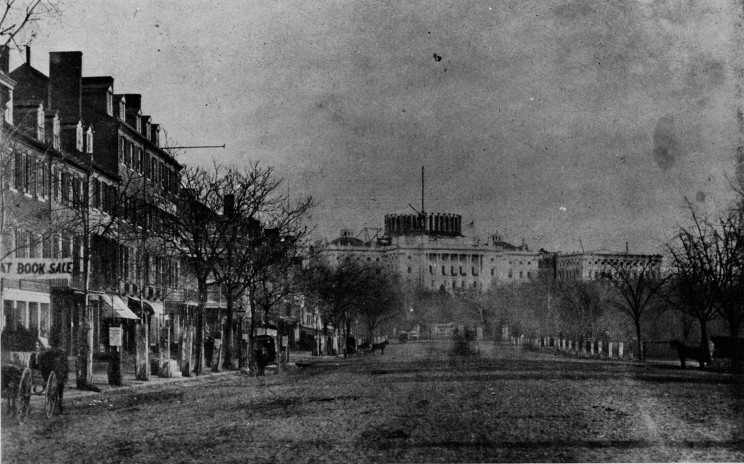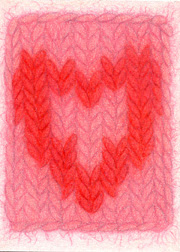By John Lockwood and Charles Lockwood
The Washington of April 1861—also commonly known as “Washington City”—was a compact town. Due to the cost of draining marshy land and the lack of reliable omnibus service, development was focused around Pennsylvania Avenue between the Capitol and White House. When the equestrian statue of George Washington was dedicated at Washington Circle in 1860, its location—three-quarters of a mile west of the White House, where Twenty-Third Street intersects Pennsylvania Avenue—was described as out of town. Several blocks north of the White House, at L Street, the land was countryside. “Go there, and you will find yourself not only out of town, away among the fields,” wrote English novelist Anthony Trollope in his travel account, North America, after his 1861 visit, “but you will find yourself beyond the fields, in an uncultivated, undrained wilderness.” A writer for the Atlantic Monthly, writing in January 1861, deemed Washington a “paradise of paradoxes,” foremost because it was both “populous” and “uninhabited” at once. Noting another paradox, he observed that the capital was ‘[d]efenceless, as regards walls, redoubts, moats, or other fortifications”—though the only party to “lay siege” to the city of late were the unyielding onslaught of politicians and office seekers, not soldiers.

Travelers arriving from northern cities caught a glimpse of the city’s grandeur and squalor as their train pulled into the B & O Station at the foot of Capitol Hill. “I looked out and saw a vast mass of white marble towering above us on the left . . . surmounted by an unfinished cupola, from which scaffold and cranes raised their black arms. This was the Capitol,” wrote Times of London correspondent William Russell, who arrived in Washington at the end of March 1861. “To the right was a cleared space of mud, sand, and fields, studded with wooden sheds and huts, beyond which, again, could be seen rudimentary streets of small red brick houses, and some church-spires above them.”
From the B & O Station, most carriages and hacks headed westward down Pennsylvania Avenue, the city’s main artery. The Avenue was the traditional route for grand parades between the Capitol and the White House, and by the mid-nineteenth-century, its north side was the location for the city’s finest hotels and shops. Yet many visitors, particularly those from leading cities like New York or London, were unimpressed by its pretensions to grandeur, and found the cityscape a formless jumble. Pennsylvania Avenue, observed Russell, was “a street of much breadth and length, lined with ailanthus trees . . . and by the most irregularly-built houses [and commercial buildings] in all kinds of materials, from deal plank to marble—of all heights.”

At the corner of Fourteenth Street, one block before Pennsylvania Avenue made its northward turn at the Treasury before continuing west past the White House, stood Willard’s Hotel. The hotel, favored by Republican Party leaders, was the center of Washington’s social and business life under the new administration. Willard’s contained “more scheming, plotting, planning heads, m
By Mark C. Carnes
General Editor, ANB
The 150th anniversary of the Civil War will be commemorated in the usual ways. But a truly unique approach is provided by the online—and thus searchable—version of the American National Biography, a 27-million word collection of biographical essays on some 18,731 deceased Americans who played a significant role in the nation’s past.
Readers can of course acquire an understanding of the major figures, perhaps beginning with James M. McPherson’s long essays on Abraham Lincoln and Ulysses S. Grant and Russell F. Weigley’s on Robert E. Lee. But there are many hundreds of essays on figures associated with all aspects of the war.
Those interested in a particular battle, for instance, can use the ANB online. A full-text search of articles for “Gettysburg” yields 253 separate biographical essays, the great majority on soldiers who fought there.
But this search also unearths many new gems of information, such as the fact that William Corby, a Roman Catholic priest assigned to New York’s Irish Brigade, stood upon a boulder, raised his right hand, and offered a general absolution for the combatants just before the armies converged.
Women, too, surface in this search. Eliza Farnham, the author of Life in Prairie Land (1846) and a crusader for prison reform and women’s causes, tended the wounded at Gettysburg, where she contracted tuberculosis; she died the next year at age 49. Eliza Turner, an early feminist, abolitionist, and poet, also cared for the wounded at Gettysburg. She later wrote an important woman suffrage tract. Elizabeth Keckley, a former slave who became the dressmaker, dresser, and confidante of Mary Lincoln, attended the Gettysburg commemoration with the first lady.
Scholars—and history buffs—can look at the Civil War from another fresh perspective through ANB searches by geographical location. For example a full-text search for “Frankfort, Kentucky,” limited to subjects between 1800 and 1840, generates nearly three dozen responses. Among the many interesting essays are those on the following:
Leonidas Polk, a graduate of West Point who became an Episcopal bishop and the owner of a Louisiana sugar plantation. At the outset of the Civil War he volunteered to command Confederate forces and Jefferson Davis named him major general for the upper Mississippi region. In September 1862, during an offensive to seize Kentucky, Polk disobeyed an order to attack, forcing Braxton Bragg to abandon Frankfort.
John Marshall Harlan, who raised and commanded the Tenth Kentucky Volunteers. His efforts helped keep Kentucky in the Union, winning for him the support of national Republicans; in 1877 President Rutherford B. Hayes nominated Harlan to the Supreme Court.
Luke Pryor Blackburn, a physician who became governor of Kentucky. He had served as the public health officer for Natchez, Mississippi, during the yellow fever epidemics of 1848 and 1854. During the Civil War the Confederacy sent Blackburn to Canada to collect arms and hospital supplies to be shipped through the Union blockade. In Canada Blackburn devised a scheme to spread yellow fever through Northern cities. To that end he traveled to Bermuda during the epidemic of 1864, collected the bedding of dying fever victims, and shipped it in trunks to cities in the North. (The plan failed: Blackburn did not understand that mosquitoes were the agent of transmission of yellow fever.) Charged with conspiracy to commit murder, Blackburn was acquitted by a Canadian court. He returned to the United States, settled in Kentucky, won a measure

Coloursofts AGAIN
on ebay
Can't...stop...drawing...yarn...
I tested the red, and I like it. Cranberry is a good color as well.
The pinks are a little "fleshy" in my opinion.
I did this one, scanned it, decided it needed something, fiddled with it, scanned it again, fiddled with it some more, scanned it again and yep, fiddled with it one more time. I ended up burnishing it a bit with white, then added more color again.
I notice that when I do actual knitting, like this one, I end up burnishing. For some reason the grainy look I do with the yarn doesn't work as well with the actual knitting. Hmmm...
~~~~~
Thanks to my friends on ScribbleTalk, I found this great site today ~ ArtRenewal.org
And because for some reason I decided I needed a "why do I bother?" moment, I looked at some of Gary Kelley's work.
I could cry.
I remember when I was a student at the Academy, for some reason we had a piece of his hanging in the display case for a while. It was an illustration of Stevie Ray Vaughn. I think it was when Gary was just starting to hit it BIG, and I that piece went on to win an award somewhere.
I have my travel mug from Barnes and Noble with his mural of the famous writers as a constant reminder of how brilliant some people are, and how...not so brilliant...some of the rest of us are.
Signed,
Debbie Downer

This is an ancient piece of art I did back in art school. It has absolutely nothing to do with what I wanted to tell you about. I just had to get your attention with something.
So a lot of us make book dummies. I found this cool thing about how to make a hardback book for those of you who like to really do it up right. This guy makes it look easy, and like a good idea. Very simple directions to follow.
AND. People ask about how to do perspective all the time. Here's a really good little tutorial. Again, easy to understand, and you can actually come away being able to do it.
In fact this whole site is cool.

A slight departure from my usual thing here.
Last night I watched Live from Lincoln Center. It was the Mostly Mozart Festival with the Mark Morris Dance Group doing the dancing and Emanauel Ax doing the piano playing.
It was fabulous.
It took me back to the 80's when I was in school at the Academy of Art. Mark Morris was doing a performance somewhere in town, and wanted some of us from the school to go over and draw them all dancing so they could hang the drawings in the lobby for the performance.
Well. I was one of the chosen few. I didn't know who he was, and thought we were going to watch some regular ballet dancers rehearse. WRONG.
They danced and we tried to draw (we could all draw well, usually, but have you ever tried to draw dancers dancing? not easy) and I was blown away.
It wasn't airy-fairy pointy toed Swan Lake kind of dancing. It was the most elegant, limbs-at-odd-angles, thumping the floor, witty, playful, intelligent moving around by people I'd ever seen.
And him! Look at him. This beautiful, cherubic creature with the curls, and how he danced. I'm swooning, remembering. We went to the actual performance as well, and it was exhilarating.
If you get a chance to see the company dance anywhere, DO.
And I must add that Emanuel Ax is no slouch at the piano, either.








Most of my dummies are hard backed and stitched. I guess I like the challenge and I love having a 'BOOK' to put back on the shelf with the neato little rejection letter tucked inside.
Some of the later ones have been done with art tape, much easier, but I still love the look and feel of the little Book dummy.